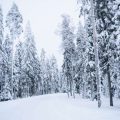Introduction to Cold Weather Camping
Cold weather camping in the United States offers a unique blend of adventure, solitude, and breathtaking winter landscapes. From the snowy peaks of the Rockies to the frosty forests of the Northeast, winter camping attracts outdoor enthusiasts who crave a challenge beyond traditional three-season adventures. However, embracing the chill comes with its own set of difficulties—freezing temperatures, unpredictable storms, and deep snow all pose real risks that can turn a dream trip into a dangerous situation without proper preparation.
The key to enjoying winter camping safely lies in understanding both its challenges and its rewards. Specialized four-season tents and sleeping gear are not just luxuries—they are essential for maintaining warmth, preventing hypothermia, and ensuring a comfortable night’s sleep. The right equipment makes it possible to wake up refreshed after a sub-zero night rather than shivering through until sunrise.
| Challenge | Impact | Required Gear Feature |
|---|---|---|
| Subzero Temperatures | Risk of hypothermia, frostbite | High-insulation sleeping bags & pads |
| Heavy Snowfall | Tent collapse or water ingress | Sturdy four-season tents with strong poles & snow skirts |
| Wind Chill | Rapid body heat loss | Aerodynamic tent designs & windproof materials |
| Dampness/Condensation | Sleepless nights, wet gear | Ventilated tents & moisture-wicking fabrics |
In this review, we’ll break down the best four-season tents and cold-weather sleeping gear designed specifically for American winters. Whether you’re planning a backcountry expedition in Colorado or a casual overnight in Minnesota’s state parks, choosing specialized gear is your ticket to safe and memorable winter camping adventures.
2. What Makes a Tent Truly Four-Season?
When you’re planning a cold weather camping trip in the U.S., picking the right four-season tent is crucial for both comfort and safety. Unlike standard three-season tents, true four-season tents are engineered to withstand the harshest conditions—think heavy snowfall, biting winds, and freezing temps from the Rockies to the Adirondacks. Here’s what to look for when choosing a tent that can handle it all:
Key Features of Four-Season Tents
| Feature | Why It Matters |
|---|---|
| Durability | Four-season tents are built with robust fabrics (often ripstop nylon or polyester) and heavy-duty poles (usually aluminum or composite materials) to handle snow loads and resist tearing in strong winds. |
| Weatherproofing | Look for tents with full-coverage rainflys, high hydrostatic head ratings, and reinforced seams. These elements keep out snow and freezing rain common during winter camping trips in areas like Yellowstone or the Sierra Nevada. |
| Ventilation | Proper ventilation is key to reducing condensation inside your tent. Features like adjustable vents, mesh panels that can be zipped closed, and dual doors help maintain airflow even in subzero conditions. |
| Setup Considerations | Four-season tents often come with more poles and secure guy-out points for added stability. Quick setup features are important when pitching your tent in deep snow or while wearing gloves. |
Other Essential Considerations
- Snow Flaps: Some four-season tents include snow flaps at the base to prevent wind-driven snow from entering the tent—great for blizzards or exposed campsites above tree line.
- Vestibule Space: Extra vestibule space helps store gear outside the sleeping area, keeping boots and packs dry without crowding the interior—a big plus for multi-day trips on the Appalachian Trail in winter.
- Pole Structure: Look for crossed pole designs or geodesic structures that offer maximum stability against wind and snow loads.
The Takeaway
A true four-season tent isn’t just about thicker material—it’s about a system of features that ensure you stay safe, warm, and dry when Mother Nature throws her worst at you. Prioritize durability, weatherproofing, smart ventilation, and thoughtful setup design so you’re ready for anything from Colorado blizzards to chilly nights in Yosemite.

3. Top-Rated Four-Season Tents Reviewed
When it comes to cold weather camping across the U.S., not all tents are built the same. Four-season tents are designed to handle everything from heavy snow in the Rockies to frigid winds on the Appalachian Trail. Below, we review some of the top-rated four-season tents that American campers rely on for winter adventures. Each tent is evaluated based on weather resistance, weight, ease of setup, and livability, so you can find the best fit for your next cold-weather expedition.
| Tent Model | Best For | Pros | Cons | Price Range (USD) |
|---|---|---|---|---|
| The North Face Mountain 25 | Extreme alpine conditions, high winds, heavy snow | Highly durable, excellent ventilation, easy setup even with gloves | A bit heavy for solo trips, pricey | $700–$800 |
| MSR Access 2 | Backpacking in moderate winter climates | Lightweight, compact design, quick pitch | Less spacious for two large adults, not ideal for blizzards | $600–$700 |
| Black Diamond Eldorado | Minimalist mountaineering and expeditions | Single-wall simplicity, fast setup, strong in storms | Condensation management needed, limited vestibule space | $800–$900 |
| Mountain Hardwear Trango 2 | Basecamps and multi-day outings in harsh winter weather | Roomy interior, bombproof construction, great gear storage | Bigger packed size, heavier than ultralight models | $750–$850 |
| Big Agnes Copper Spur HV Expedition 2 | Versatile use from car camping to backcountry trips | Good balance of weight and warmth, innovative features like oversized vestibules | Zippers can snag in icy conditions, higher price tag | $700–$800 |
Choosing the Right Tent for Your Winter Adventure
Selecting a four-season tent depends on where you’re headed and how you camp. If you’re planning serious alpine ascents or need a shelter that laughs at mountain storms, options like The North Face Mountain 25 or Mountain Hardwear Trango 2 are trusted by American mountaineers. For backpackers wanting lighter loads without sacrificing too much protection, the MSR Access 2 is a favorite in milder winter climates. Solo adventurers or minimalist climbers may prefer the Black Diamond Eldorado’s compact footprint.
Remember: Always consider both the expected weather and your group size when choosing a winter tent. Features like double-wall construction help with condensation management in humid regions like the Pacific Northwest, while reinforced poles and guy lines are essential for windy plains or exposed peaks.
Pro Tip:
If you’re new to winter camping in America’s diverse climates, try borrowing or renting different tents before buying—many outdoor retailers offer rentals so you can test what works best for your style and region.
4. Sleeping Bags and Pads: Staying Warm at Night
When temperatures drop, having the right sleeping bag and pad setup is crucial for a safe and comfortable night outdoors. Choosing gear specifically rated for cold weather is more than a luxury—its essential. Here’s what you need to know about selecting the best sleeping bags and pads for winter camping in the U.S.
Understanding Temperature Ratings
Sleeping bags are labeled with temperature ratings, which indicate the lowest temperature at which they’ll keep an “average sleeper” warm. For winter camping, look for bags rated at least 10°F lower than the expected nighttime low. The EN/ISO ratings used in North America help standardize these numbers, but always err on the side of caution if you sleep cold.
Insulation Types
| Type | Pros | Cons |
|---|---|---|
| Down | Lightweight, highly compressible, excellent warmth-to-weight ratio | Loses insulation when wet, pricier |
| Synthetic | Insulates even when damp, generally less expensive | Bulkier, heavier for same warmth rating |
In snowy or damp climates like the Pacific Northwest or Rockies, many American campers opt for high-quality treated down or premium synthetics to balance warmth and moisture resistance.
Layering Your Sleep System
- Add a sleeping bag liner for extra warmth (can boost rating by 10-15°F)
- Wear dry thermal base layers to bed—avoid overdressing as this can cause sweating and heat loss
The Role of Sleeping Pads
The ground pulls heat away rapidly—using an insulated sleeping pad is non-negotiable in cold weather. Pay attention to the R-value (insulation rating) of pads; for four-season use in the U.S., an R-value of 4 or higher is recommended.
| Pad Type | R-Value Range | Best For |
|---|---|---|
| Foam Closed-Cell | 2-3.5 | Mild winters, layering under inflatable pads |
| Self-Inflating | 3-5+ | Main pad for most winter trips |
| Inflatable (with insulation) | 4-7+ | Extreme cold, high-altitude expeditions |
Pro Tips from American Campers:
- Double up pads if you’re expecting sub-zero temps—use a foam pad under an inflatable for extra insulation.
- If car camping, consider adding a wool blanket between your pad and bag for added comfort.
A Final Word:
Your sleep system is your lifeline in cold weather. Invest wisely in gear that matches your destination’s climate and your body’s needs—you’ll wake up warmer, safer, and ready to tackle the day’s adventure.
5. Expert Tips for Safe and Comfortable Winter Camping
When it comes to cold weather camping, a little know-how goes a long way toward making your experience both safe and enjoyable. Here are hot tips and key strategies from seasoned U.S. campers to help you stay warm, dry, and secure during your winter adventures.
Layer Up Like a Pro
Effective layering is crucial for temperature regulation. Use the classic three-layer system: a moisture-wicking base, an insulating middle, and a waterproof outer shell. Avoid cotton—it holds moisture and will chill you fast.
Three-Layer Clothing System
| Layer | Purpose | Recommended Materials |
|---|---|---|
| Base | Wicks sweat away from skin | Merino wool, synthetic blends |
| Middle | Traps body heat | Fleece, down, synthetic insulation |
| Outer (Shell) | Blocks wind and water | Gore-Tex, nylon, waterproof breathable fabrics |
Setting Up Camp: Choose Wisely
Select a campsite sheltered from prevailing winds—look for natural windbreaks like trees or hills. Always clear snow from your tent site and use a footprint or tarp underneath your tent to add an extra layer of insulation and keep out moisture.
Mastering Your Tent Setup
- Tightly stake down your four-season tent to prevent snow drift entry.
- Use guylines for extra stability against strong winter gusts.
- Create a shallow trench at the entrance to minimize snow buildup inside the vestibule.
- Avoid breathing directly into your sleeping bag to reduce condensation and freezing inside your gear.
Hot Tips for Staying Warm Overnight
- Add an insulated sleeping pad with a high R-value under your bag—stack two if needed.
- Eat a hot meal before bed; digestion boosts core warmth.
- Fill a Nalgene bottle with hot (not boiling) water and stash it in your bag for lasting heat.
- Wear a beanie or balaclava while sleeping—most heat loss happens through the head.
- If you wake up chilly, do some gentle exercises (like sit-ups) in your bag to warm up quickly.
Packing Essentials for Safety & Comfort
| Item | Purpose/Tip |
|---|---|
| Bivy sack or emergency blanket | Adds critical warmth in emergencies |
| Chemical hand/foot warmers | Saves digits in frigid temps—keep extras handy! |
| Synthetic or down booties/slippers | Keeps feet cozy inside the tent at night |
| Duct tape & repair kit | Fix ripped tents or broken poles on the fly |
| Sunscreen & sunglasses | Snow glare burns just as much as summer sun! |
| Headlamp with spare batteries | Essential for dark winter nights (batteries drain faster in cold) |
Cultural Pro Tip from U.S. Campers:
“Leave No Trace” applies year-round—even when snow covers the ground! Pack out all trash, avoid damaging fragile winter habitats, and respect wildlife that may be especially vulnerable during colder months.
6. Gear Maintenance and Packing Advice
How to Care for Your Winter Camping Gear
Cold weather adventures demand reliable equipment, and keeping your four-season tent and sleeping gear in top condition is crucial for both safety and comfort. Proper maintenance before and after your trip helps extend the life of your gear and ensures it performs when you need it most.
Pre-Trip Preparation
- Inspect: Check your tent for tears, broken poles, or faulty zippers. Examine sleeping bags and pads for any holes or damaged insulation.
- Clean: Remove dirt, debris, and moisture from all equipment. For sleeping bags, follow manufacturer instructions—most down bags require special detergents.
- Treat: Reapply water-repellent coatings to rainflys or outer shells if needed.
Post-Trip Cleaning & Storage
- Dry Everything Thoroughly: Moisture trapped in fabrics can lead to mold or mildew. Hang your tent, bag, and pad in a well-ventilated area until completely dry.
- Spot Clean: Use mild soap on dirty spots; avoid harsh chemicals that could degrade materials.
- Store Loosely: Keep sleeping bags uncompressed in a large sack or hung up, and store tents loosely folded rather than tightly packed to preserve waterproof coatings and fabric integrity.
Packing Best Practices for Harsh Conditions
The way you pack your winter camping gear can make a significant difference in how it performs under pressure. Here’s a quick-reference table with packing tips tailored for cold-weather conditions:
| Item | Packing Tip |
|---|---|
| Tent | Separate poles/stakes from fabric to prevent punctures; keep in an easy-access spot for quick setup. |
| Sleeping Bag | Use a waterproof compression sack to reduce size and protect from moisture. |
| Sleeping Pad | Roll tightly; secure outside pack if space is limited but ensure its covered from snow/rain exposure. |
| Shelter Accessories (stakes, guylines) | Group together in a mesh bag; double-check count before leaving home and trailhead. |
Packing Checklist Before You Leave Home
- Tent (all components: body, fly, stakes, poles)
- Four-season sleeping bag rated for expected lows
- Insulated sleeping pad(s)
- Tent footprint or groundsheet
- Duct tape/repair kit
A little extra care before and after each adventure will keep your winter camping gear ready for whatever the American wilderness throws at you—whether youre heading into the Rockies, Sierras, or Adirondacks. Smart packing helps prevent surprises so you can focus on enjoying those frosty nights under the stars.


